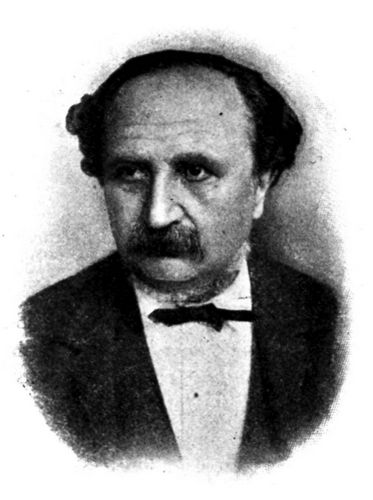Joseph von Gerlach on:
[Wikipedia]
[Google]
[Amazon]
 Joseph von Gerlach (3 April 1820 – 17 December 1896) was a German professor of
Joseph von Gerlach (3 April 1820 – 17 December 1896) was a German professor of
 Joseph von Gerlach (3 April 1820 – 17 December 1896) was a German professor of
Joseph von Gerlach (3 April 1820 – 17 December 1896) was a German professor of anatomy
Anatomy () is the branch of biology concerned with the study of the structure of organisms and their parts. Anatomy is a branch of natural science that deals with the structural organization of living things. It is an old science, having it ...
at the University of Erlangen
A university () is an institution of higher (or tertiary) education and research which awards academic degrees in several academic disciplines. Universities typically offer both undergraduate and postgraduate programs. In the United States, th ...
. He was a native of Mainz
Mainz () is the capital and largest city of Rhineland-Palatinate, Germany.
Mainz is on the left bank of the Rhine, opposite to the place that the Main joins the Rhine. Downstream of the confluence, the Rhine flows to the north-west, with Ma ...
, Rhineland-Palatinate
Rhineland-Palatinate ( , ; german: link=no, Rheinland-Pfalz ; lb, Rheinland-Pfalz ; pfl, Rhoilond-Palz) is a western state of Germany. It covers and has about 4.05 million residents. It is the ninth largest and sixth most populous of the ...
. Gerlach was a pioneer of histological staining
Staining is a technique used to enhance contrast in samples, generally at the microscopic level. Stains and dyes are frequently used in histology (microscopic study of biological tissues), in cytology (microscopic study of cells), and in the m ...
and anatomical micrography
Micrography (from Greek, literally small-writing – "Μικρογραφία"), also called microcalligraphy, is a Jewish form of calligrams developed in the 9th century, with parallels in Christianity and Islam,carmine mixed with gelatin as a histological stain.
Along with Camillo Golgi, he was a major proponent of the reticular theory that the brain's
Neurophilosophy.wordpress
On discovery of the neuron * This article incorporates information based on a translation of an equivalent article at the German Wikipedia.
Laboratory Manual of Human Anatomy
1820 births 1896 deaths German anatomists Physicians from Mainz University of Erlangen-Nuremberg faculty German histologists People from Rhenish Hesse {{Germany-academic-bio-stub
nervous system
In biology, the nervous system is the highly complex part of an animal that coordinates its actions and sensory information by transmitting signals to and from different parts of its body. The nervous system detects environmental changes ...
consisted of processes of contiguous cells fused to create a massive meshed network. Gerlach summed up his theory by stating:the finest divisions of the protoplasmic processes ultimately take part in the formation of the fine nerve fibre network which I consider to be an essential constituent of the gray matter of the spinal cord. The divisions are none other than the beginnings of this nerve fibre net. The cells of the gray matter are therefore doubly connected by means the nerve process which becomes the axis fibre and through the finest branches of the protoplasmic processes which become a part of the fine nerve fibre net of the gray matter.The reticular theory predominated until the 1890s when Ramon y Cajal brought forth his
neuron doctrine
The neuron doctrine is the concept that the nervous system is made up of discrete individual cells, a discovery due to decisive neuro-anatomical work of Santiago Ramón y Cajal and later presented by, among others, H. Waldeyer-Hartz. The term '' ...
of synaptic junctions, which in essence replaced the reticular theory.
Gerlach was one of the first physicians to use photomicrography for medical research. In 1863 he published a handbook titled ''Die Photographie als Hilfsmittel mikroskopischer Forschung'' (Engl. "Photography as a tool in microscopic science") in which he discusses the practical and technological aspects of microscopic photography.
The eponymous "Gerlach's valve" (''valvula processus vermiformis'') is named after him. This anatomical structure is a fold of membrane sometimes found at the opening of the vermiform appendix
The appendix (or vermiform appendix; also cecal r caecalappendix; vermix; or vermiform process) is a finger-like, blind-ended tube connected to the cecum, from which it develops in the embryo. The cecum is a pouch-like structure of the large ...
. In his article ''Ueber das Hautathmen''von Gerlach, J. (1851): ''Ueber das Hautathmen''. In: ''Archiv für Anatomie, Physiologie und wissenschaftliche Medicin''. pp. 431–455 (Engl. "On skin respiration") he was the first to show that human skin uses oxygen from ambient air.
References
Neurophilosophy.wordpress
On discovery of the neuron * This article incorporates information based on a translation of an equivalent article at the German Wikipedia.
External links
*Laboratory Manual of Human Anatomy
1820 births 1896 deaths German anatomists Physicians from Mainz University of Erlangen-Nuremberg faculty German histologists People from Rhenish Hesse {{Germany-academic-bio-stub